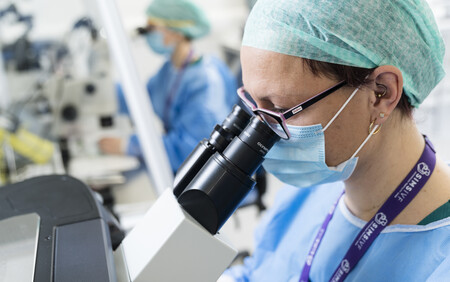
Preimplantation Genetic Testing for Aneuploidy (PGT-A)
What is Preimplantation Genetic Testing for Aneuploidy (PGT-A)?
Preimplantation Genetic Testing for Aneuploidy (PGT-A) (Formerly known as PGS) is a specialised diagnostic technique that can be used to test embryos for a chromosomal abnormality. This technique offers an earlier test than alternative antenatal screening tests, which are normally offered between 11-14 weeks of pregnancy.
What is a chromosomal abnormality?
Chromosomes contain the genetic material we inherit from our parents. Normal cells contain 46 chromosomes arranged in 22 pairs plus the sex chromosomes X and Y. Sometimes, errors occur in the egg or sperm that result in extra or missing chromosome in the embryo. This is known as aneuploidy.
Having a missing chromosome is termed monosomy. Having an extra chromosome is known as trisomy. The most common of these is trisomy 21, known as Down’s syndrome.
Studies have shown that, in some cases, difficulty in achieving a pregnancy is caused by losses or increases in the number of chromosomes in the embryo. An aneuploid embryo is unlikely to implant or go to term.
Who is PGT-A suitable for?
PGT-A may be recommended in a variety of clinical situations including:
- Older women who are at increased risk of having a baby with a chromosomal problem such as Down’s syndrome
- Women who have had a previous pregnancy with a chromosomal problem
- A history of recurrent miscarriage
- Repeated IVF failure
What does PGT-A involve?
PGT-A begins with IVF treatment to create embryos. Genetic analysis is performed on the embryo development on day 5 (blastocyst biopsy). The material removed from the embryo is then examined to see if there are any gains or losses in the number of chromosomes. These step are explained in more details below:
- Creating embryos: The only way to create embryos for PGT-A is through IVF or ICSI treatment. You will be given specific information regarding your treatment protocol, which will be identical to any patients undergoing IVF/ICSI treatment to create embryos.
- Analysing embryos: A small hole is made in the outer shell of the embryo and a fine needle passed inside the embryo to remove a collection of cells for day 5 biopsy. The cells analysed do not come from those cells producing the embryo (baby) but from extra-embryonic cells that will go on to form the placenta. The material removed from the embryos is analysed using a technique called Next Generation Sequencing (NGS), which provides information about all 23 pairs of chromosomes. This analysis is able to tell us whether an embryo is likely to have a normal number of chromosomes. Biopsied embryos are then vitrified (fast frozen) whilst results are analysed.
- Getting results: The results of this test typically take up to 4 weeks from the time of biopsy to process as samples are batched for analysis to reduce the cost to the patient. NGS is thought to be more sensitive than other older techniques such as comparative genomic hybridisation (CGH).
- Storing embryos: The recommendation for PGT-A cycles is to freeze all biopsied embryos without transfer until the results of the genetic analysis are known. Typically preparation for this can start approximately 6 weeks after egg collection.
How much does PGT-A cost?
The cost of PGT-A is shown in the pricing section of this website and is available on request from Sims IVF. Our team are happy to explain our package and what is included in the cost.
Possible results from PGT-A analysis of embryos
There are several results that can be generated from PGT-A.
- Normal embryo – shows a normal number of chromosomes and suitable for transfer
- Abnormal embryo – shows significant losses or deletions of chromosomes and not suitable for transfer
- Partial deletions – shows a small amount of genetic information missing from one or more chromosomes but not complete loss of a chromosome. Some of these embryos may be suitable for transfer but may have less chance of pregnancy.
- Mosaic – shows a mixture of normal and abnormal cells within those analysed. Some of these embryos may be suitable for transfer but may have less chance of pregnancy. See “Risks of PGT-A”
- No result – it was not possible to analyse the genetic information sent to the lab. This happens in approx. 5% of embryos biopsied.
Sadly, it is possible for all the embryos analysed to be abnormal and therefore for no embryo transfer to happen. There is an association between maternal age and the number of embryos produced in a cycle. Cycles producing more embryos from younger couples have an increased chance of having at least one normal embryo but this is not guaranteed and may also depend on the reason for PGT-A. It is important to know that not all pregnancies conceived following PGT-A continue to full term and that miscarriage can still happen.
Success rates of PGT-A
Recent sources from laboratories providing this technique to clinics have suggested clinical pregnancy rates as high as 65% per cycle with transfer of a euploid embryo. Unlike undiagnosed embryos the chances of success appear to be similar across all age groups. Recent studies suggest PGT-A can improve clinical pregnancy rates and decease miscarriage rates although more trials are needed before we can be reassured that this technique is effective and can be applied in routine practice.
What are the risks of PGT-A?
- Risk of PGS Misdiagnosis: The chromosomes in an embryo may not be the same in every cell. This is known as chromosomal mosaicism. By sampling a larger number of cells in a day 5 embryo this risk becomes reduced in comparison with sampling a single cell in earlier embryos. PGT-A accuracy is approximately 98-99% however ante- natal screening may be recommended in addition.
- Damage to the embryo: To remove cells from an embryo a small hole is made in the outer coating by a laser and a small amount of genetic material removed. This may, in a small number of cases, lead to damage of the embryo.
- Long-term effects on pregnancy: Research so far suggests that removal of cells from the embryo does not cause harm. Embryos continue to divide and appear to develop normally in the same way as embryos which have been frozen may lose some cells on thawing but continue to develop in to normal pregnancies. However, in spite of all the positive evidence gained so far preimplantation genetic screening is still an experimental and uncertain procedure. Even though thousands of babies have been born after embryo biopsy there is no evidence of the long-term safety of this technique.
Genetic Counselling
Specialist genetic counselling may help some couples, both before and after a treatment cycle to help decide whether this is a technique you should use for your treatment but also to help in the interpretation of results from embryo biopsy, please ask your doctor. In addition, general infertility counselling to all our patients is also available.
PGT-M and PGT-SR are also available if required by your doctor
PGT-M can be used for diagnosis of a genetic disease in embryos prior to implantation and pregnancy.
PGT-SR can help identify embryos with the correct amount of chromosomal material that are most likely to lead to a successful pregnancy and healthy live birth.
Available in our Clonskeagh clinic only. Please contact Clonskeagh for costs.
Can PGT-A help me get pregnant?
To find out whether PGT-A can help you fall pregnant, please book an appointment with a Sims IVF fertility specialist or contact us.
